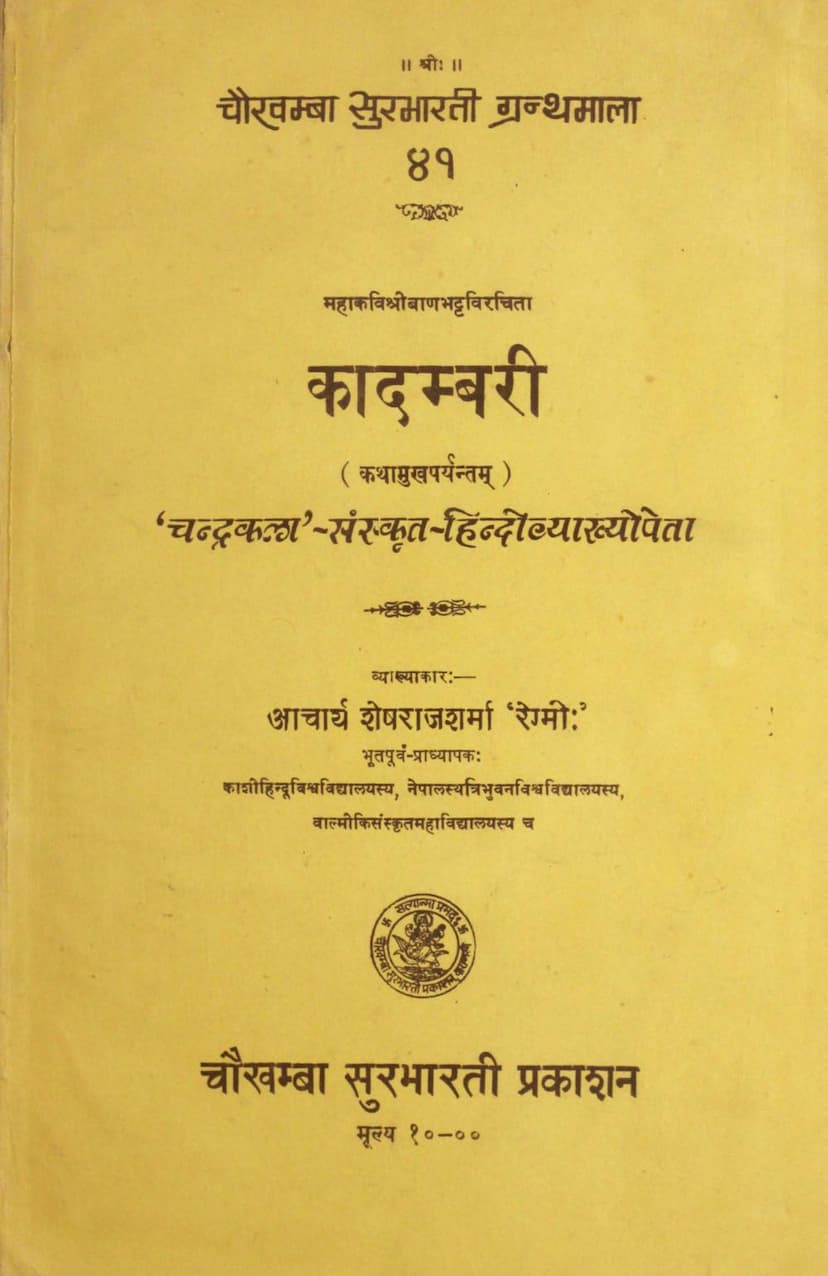Kadambari
Added to library: September 2, 2025

Summary
This text appears to be the catalog description and a part of the introduction to the Jain text "Kadambari" by Banabhatta Mahakavi, with commentaries by Sheshraj Sharma. Here's a breakdown of the key information:
Book Title: Kadambari Author: Banabhatta Mahakavi Commentaries/Editor: Acharya Shesharaja Sharma 'Regmi' (Former Professor at Banaras Hindu University, Tribhuvan University Nepal, and Valmiki Sanskrit College) Publisher: Chaukhamba Surabharati Prakashan (also referred to as Chaukhamba Vidyabhavan) Catalog Link: https://jainqq.org/explore/009564/1 Edition: First Edition (1976 for Kathavmukhaparyantam, 1979 for Purvardha) Price: Rs. 8.00 for Kathavmukhaparyantam, Rs. 35.00 for Purvardha (prices for the 1979 edition).
Content Overview (from the Introduction):
The introduction discusses the nature of language and its expression through prose (Gadya) and poetry (Padya). It traces the origins and development of both forms in Sanskrit literature, starting from the Rigveda, Samaveda, Yajurveda, and Atharvaveda. It highlights the prevalence of poetry in Vedic literature and the gradual emergence of prose.
The introduction then delves into the classification of Sanskrit literature, particularly focusing on prose poetry (Gadya Kavyas):
- Types of Poetry: Dhrushya (Dramatic) and Shravya (Auditory). Shravya is further divided into Gadya and Padya.
- Types of Prose (Gadya): Muktaka, Vrittagandhi, Utkalikaprayam, and Churnaka, with brief descriptions.
- Genres of Prose Poetry: Katha and Akhyayika, with definitions and examples from Vishwanath Kaviraj's Sahitya Darpan. Examples of Katha include Dandin's Dashakumaracharita, Banabhatta's Kadambari, and Dhanapala's Tilakamanjari. Harsha's Harshacharita is given as an example of Akhyayika.
- Key Prose Poets: The introduction identifies Dandin, Subandhu, and Banabhatta as the three most prominent Sanskrit prose poets.
- Dandin: Discussed as potentially the earliest prose poet, his works like Dashakumaracharita and Kavyadarsha are mentioned. His possible southern Indian origin and influences are noted, suggesting he came after Kalidasa and Pravarasena.
- Subandhu: Positioned after Dandin, his work Vasavadatta is described as an Akhyayika, noted for its "Pratyaksharaslesh" (alliteration/pun in every letter). His time is placed between the 6th and 7th centuries CE, based on references to Udyotkara Muni and Dharmakirti.
- Banabhatta: Identified as a contemporary of King Harshavardhana of Kannauj (7th century CE). His major works mentioned are Harshacharita (Akhyayika) and Kadambari (Katha). The introduction acknowledges that Kadambari, like Harshacharita, is incomplete. It also mentions his other works and lineage based on Harshacharita.
- Kadambari's Significance: The text emphasizes Kadambari's "Lokottarta" (supernatural) quality in terms of plot, ornamentation, breadth of description, and scholarly depth. It states that the entire world is "Banocchistam" (leftovers from Bana), signifying the comprehensive nature of his writing. The beauty of its language, style, and descriptions are highlighted, with a quote suggesting its captivating nature makes even food unappealing to its readers. The introduction mentions various figures and events described in Kadambari, such as King Shudrak, Chandrapida, Mahashweta, Kadambari, Pattaleka, and the teachings of Shukanas.
- Commentaries: The introduction mentions the existence of four known commentaries on Kadambari, including those by Bhanuchandra, Siddhichandra, Haridasa Siddhantavagish, Moreshwar Ramchandra Kale, and Krishnamohan Shastri. The current edition includes Acharya Shesharaja Sharma's "Chandrakala" commentary with Sanskrit and Hindi explanations.
The provided pages of the text include:
- Page 1-5: Title pages, publisher details, and edition information in both Sanskrit and English, highlighting the commentaries.
- Page 6-15: The introductory "Upoaaghatra" (Introduction), discussing literature, prose, poetry, and the historical context and contributions of Dandin, Subandhu, and Banabhatta, with a particular focus on Kadambari.
- Page 16-18: Praise (Prashasti) for Banabhatta from various poets and scholars, followed by a discussion of the characters and literary aspects (Riti, Guna, Rasa) of Kadambari.
- Page 19-49: The beginning of the narrative, starting with the Mangalacharan (auspicious invocation) and the description of King Shudrak, followed by the introduction of the parrot Vaishampayana and the story of King Tarapida, Prince Chandrapida, Mahashweta, and Kadambari. This section details the initial plot points and character introductions.
- Page 50 onwards: Continues the narrative, describing the forest (Vindhyatavi), the Ashram of Jabali, and the teachings of Hārīta. It also includes the story of the parrot Vaishampayana's past life and its encounter with the old hunter.
In essence, this Jain catalog entry describes a scholarly edition of Banabhatta's Kadambari, a seminal work in Sanskrit prose literature. The introduction provides a comprehensive overview of the classification and history of Sanskrit prose, highlighting the significance and stylistic features of Kadambari and its author.